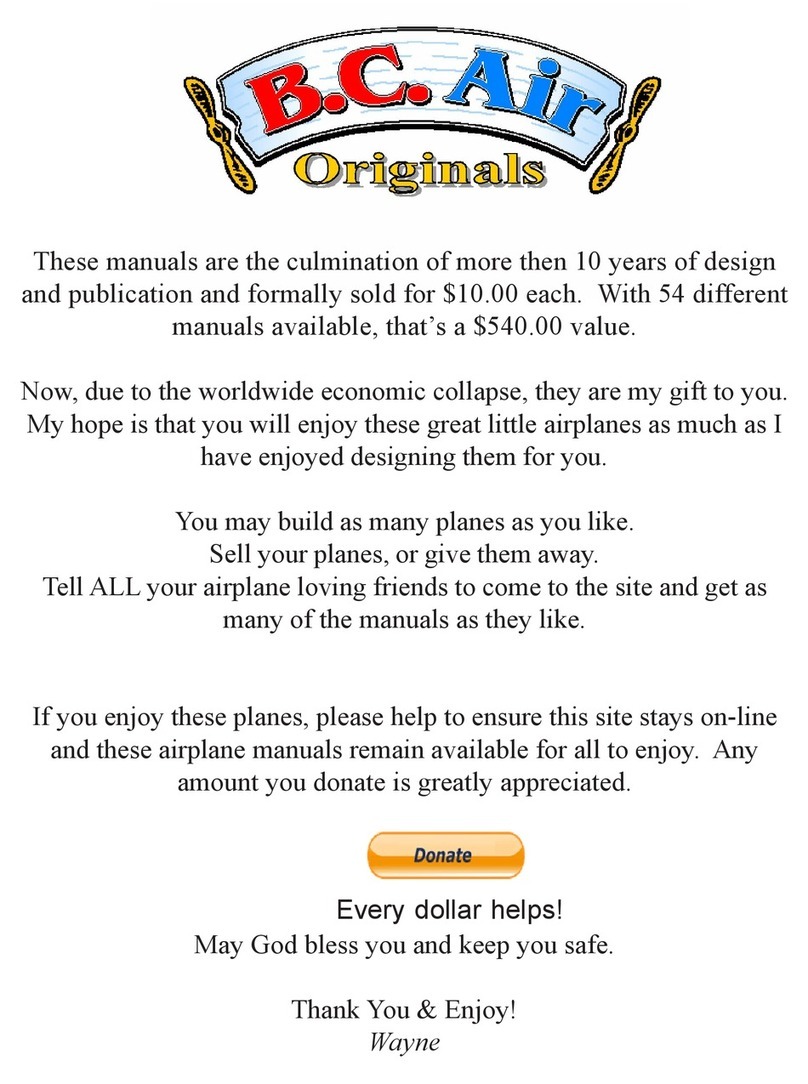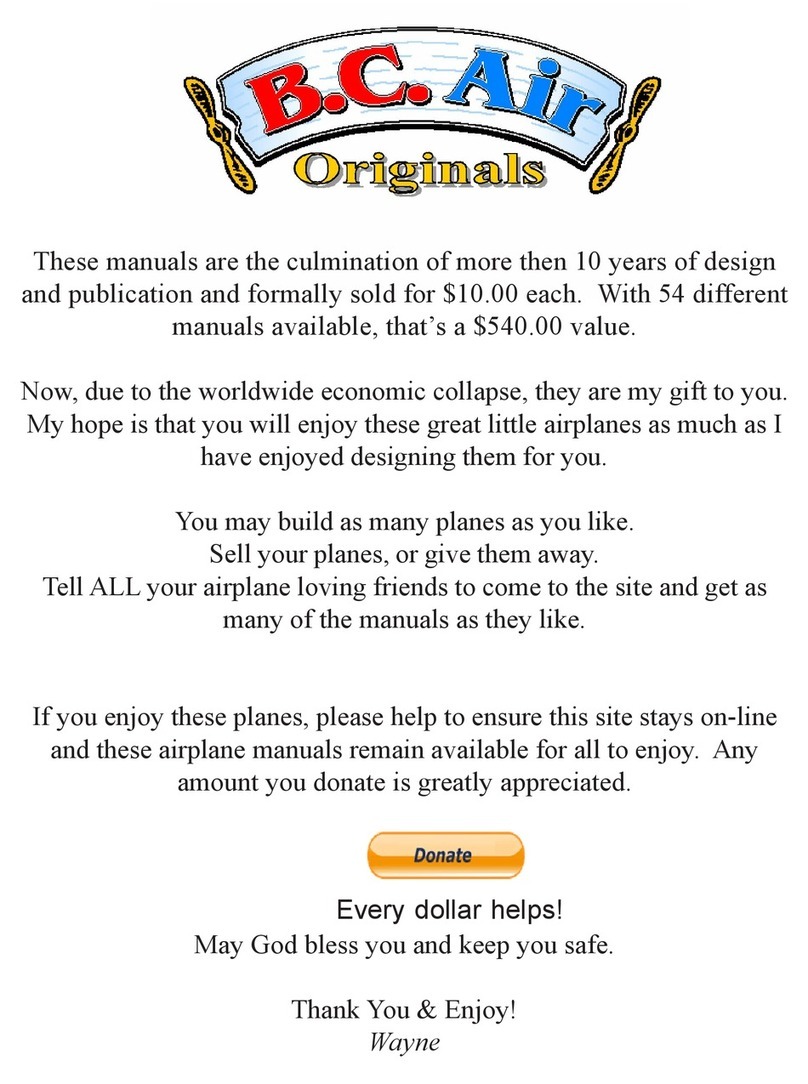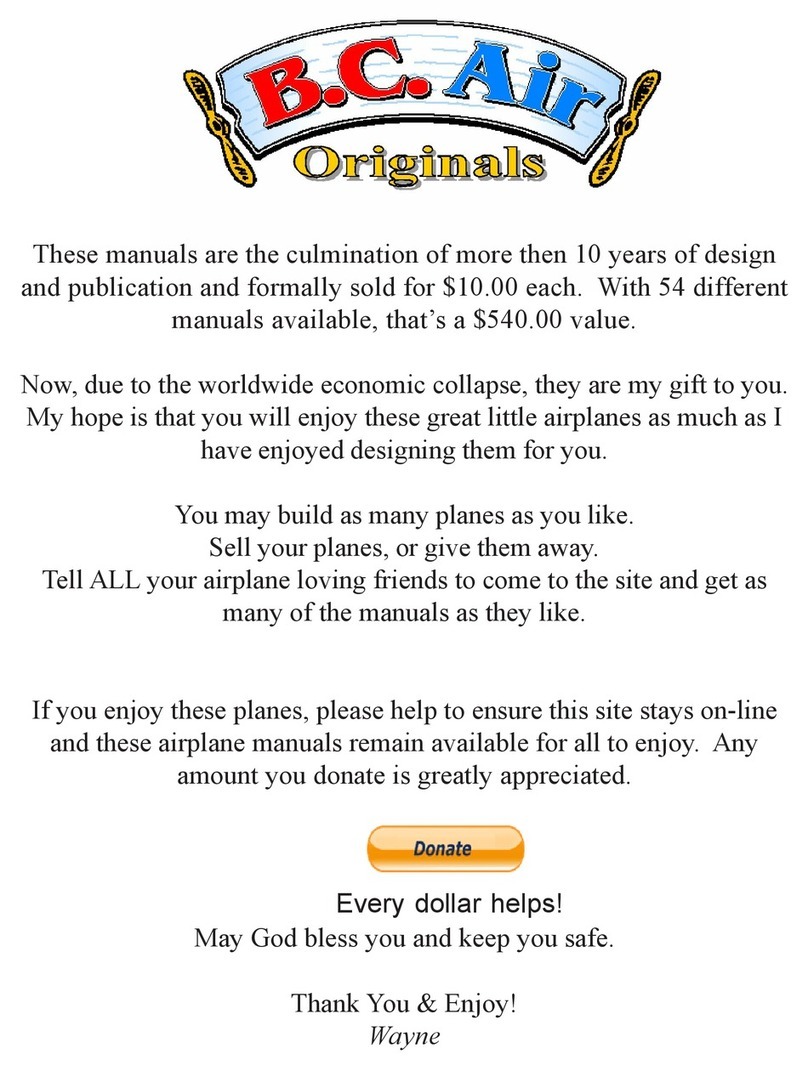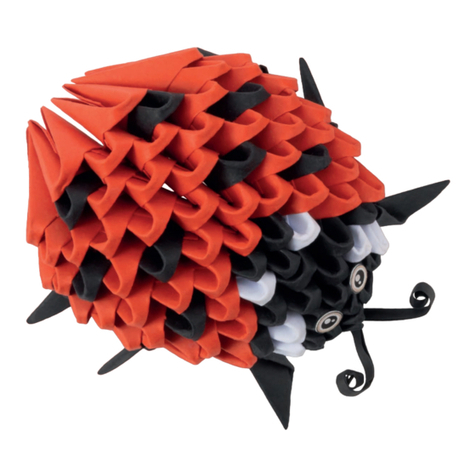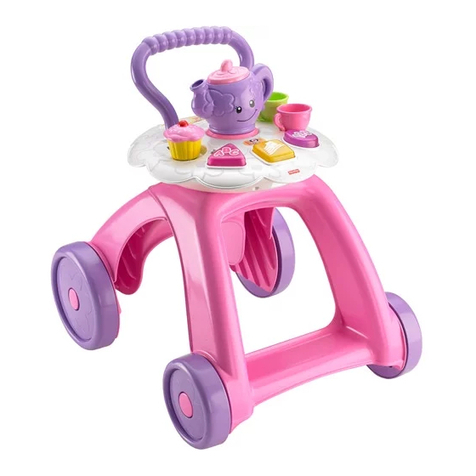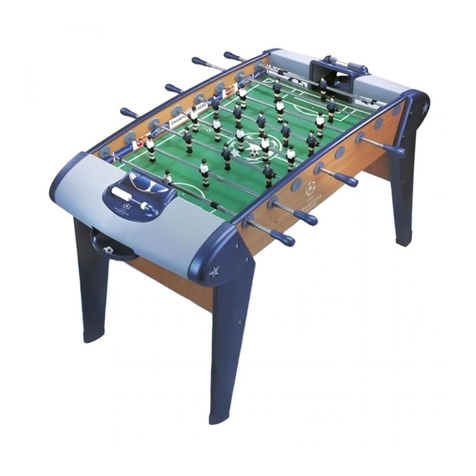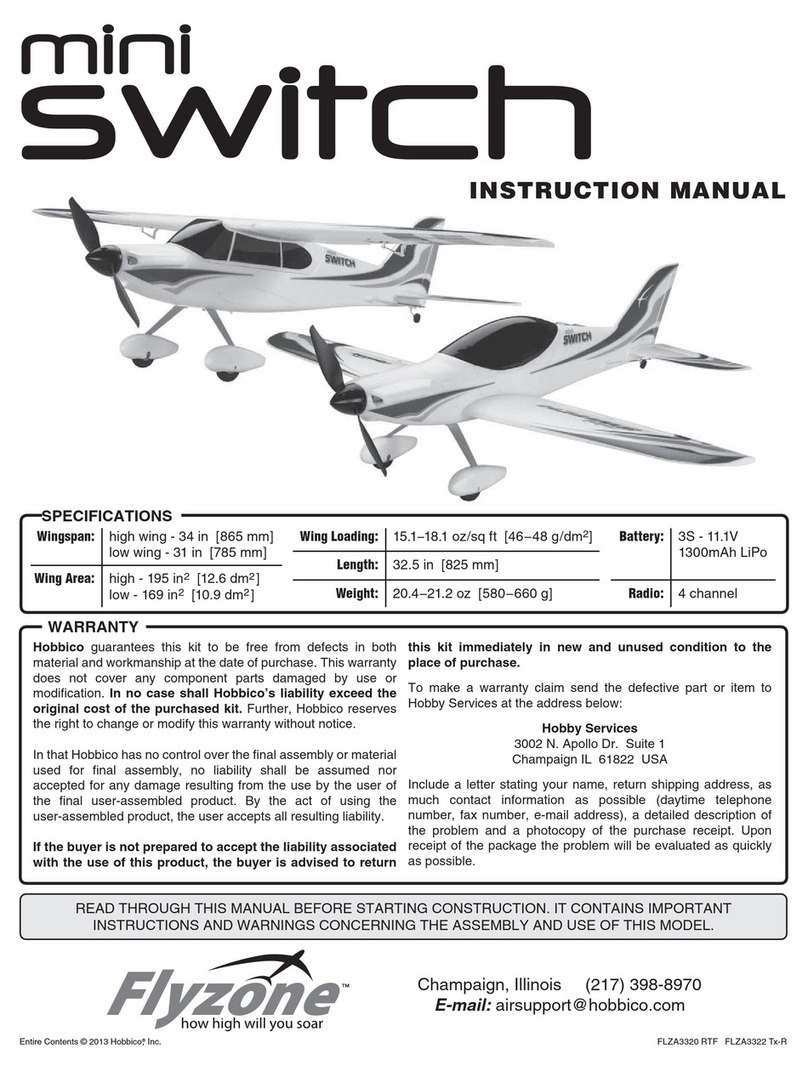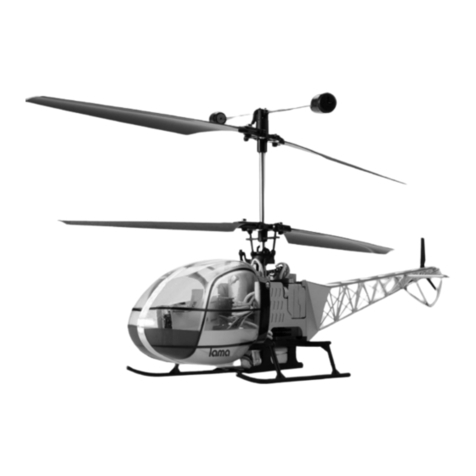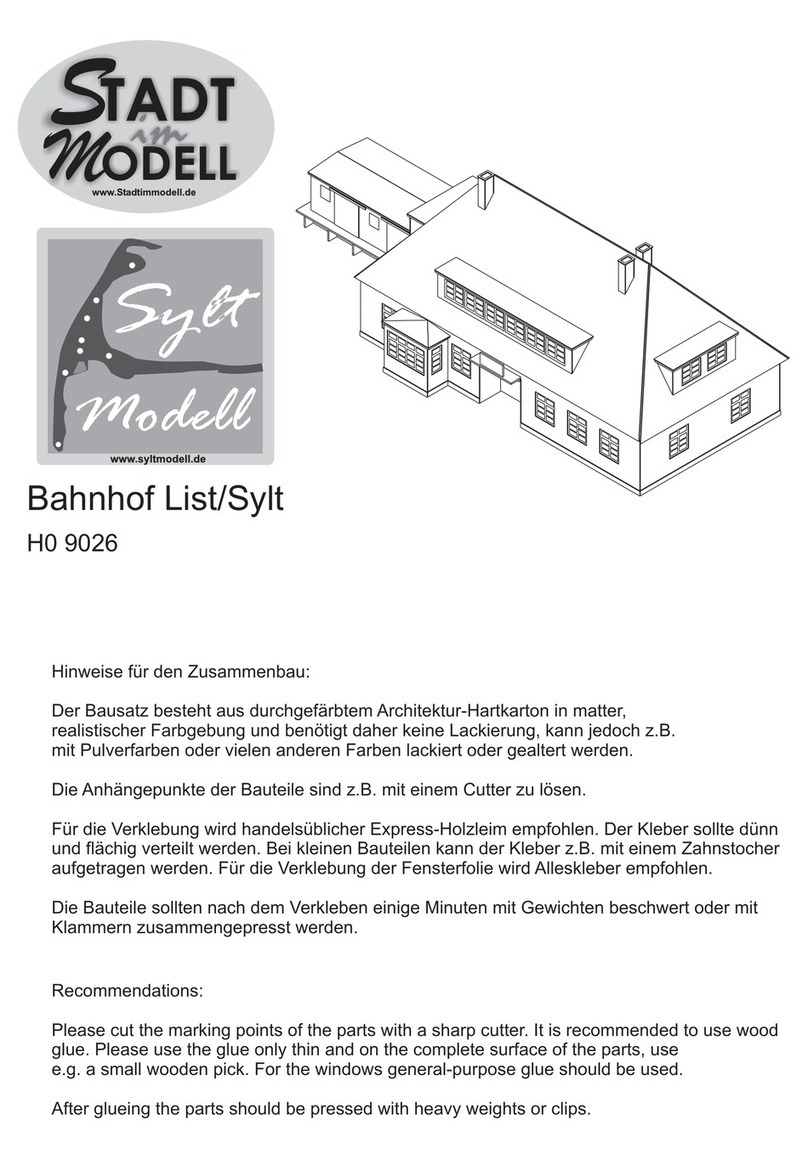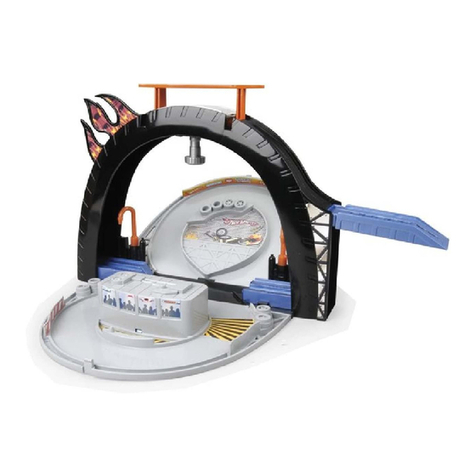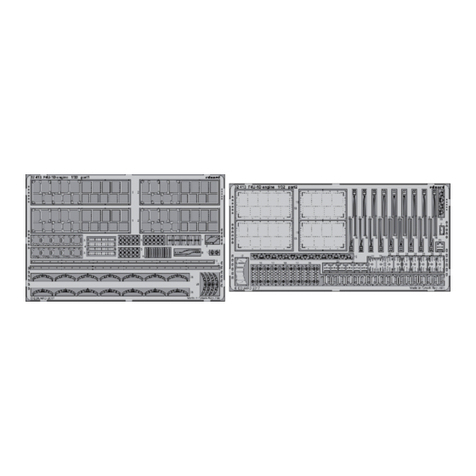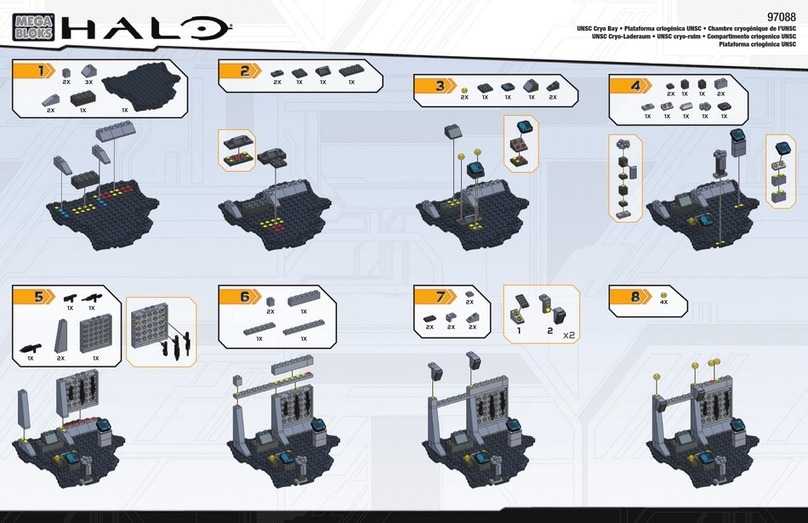B.C. Air Bonanza Beechcraft V-35 User manual

Every dollar helps!
These manuals are the culmination of more then 10 years of design
and publication and formally sold for $10.00 each. With 54 different
manuals available, that’s a $540.00 value.
Now, due to the worldwide economic collapse, they are my gift to you.
My hope is that you will enjoy these great little airplanes as much as I
have enjoyed designing them for you.
You may build as many planes as you like.
Sell your planes, or give them away.
Tell ALL your airplane loving friends to come to the site and get as
many of the manuals as they like.
If you enjoy these planes, please help to ensure this site stays on-line
and these airplane manuals remain available for all to enjoy. Any
amount you donate is greatly appreciated.
May God bless you and keep you safe.
Thank You & Enjoy!
Wayne

www.bcair.com
Copyright © 2006 B. C. Air Originals
TOP SECRET
Step By Step Construction Plans.
23 Pages With Over 90 Full Color Photos
showing how to build the
Can be made from
most 12oz Beverage Cans.
Wingspan: 18”
Length: 15”
Height: 5”
Beechcraft V-35
Bonanza

Welcome to the B. C. Air Originals Squadron.
This booklet contains complete step by step instructions for building the B. C. Air
Originals Beechcraft V-35 Bonanza. Before you start building your first plane it
is suggested that you review the entire set of plan directions. Once you have pre-
viewed the construction steps you should start collecting the cans that you want to
use to make your first plane. These plans are designed to be used with any 12 oz.
beverage can. Always use clean, unscratched and undented cans for the best looking
planes.
Since the building of these planes requires the cutting of cans and the use of sharp
tools, CHILDREN SHOULD NEVER ATTEMPT THE CONSTRUCTION OF
THESE PLANES WITHOUT ADULT SUPERVISION AND GUIDANCE.
CONSUMER ACCEPTS ALL RESPONSIBILITY FOR ANY INJURY IN-
CURRED IN THE BUILDING OF THESE PLANES.
It is not necessary to follow all the building steps in the order presented. Such as, if
you want to make the Engine, or the Wheels first, you can do that and then set them
aside until you need them. However, until you understand the construction of these
planes, it may be easier to follow the steps in the order listed. Your very first step
should be to make a copy of all the templates. All templates are drawn to scale.
Using a sheet of mylar (Clear Plastic) will enable you to re-use your templates again
and again. There is no limit to the number of planes you can build with these plans.
We, at B. C. Air Originals, will make every effort to assist you in answering any
questions you may have about the construction of these planes. Please feel free to
Thank you for your interest in the B. C. Air Originals and have FUN!
D. P. (Wayne) Mathis

When you print your manuals be sure that your printer is set on it’s MAX
printing area to ensure that all the templates print out to the correct size.
The standard 12 oz Can, here in the US, measures 2 1/2" in diameter. If the
Cans you’re using to make your plane are smaller or larger, then here’s
what you do..... Measure the diameter of your Can and find what percent-
age of 2 1/2" it is.... I.e. If your Can measures only 2 1/4" (in diameter)
then 2 1/4" is = to 90% of 2 1/2" so you would print out all the templates
at 90% instead of at 100%. If your Can measures 3" (in diameter) then 3"
is = to 120% of 2 1/2" so you would print out all of the templates at 120%.
etc.
Some of these models were originally designed in 1984. Since then the
building techniques of these planes has changed over time. I.e. many of the
planes no longer require the use of the wooden former “F-1 & F-2”. We
simply glue the “B-2’s” onto the BACK (BOTTOM) of the Can “B-1” or
use corrugated cardboard in place of the wood. (See http://
www.bcair.com/BT/nwf1.htm and http://www.bcair.com/BT/nf1.htm )
Once you’ve reviewed your manual and you’re ready to start your first
plane, go here > http://www.bcair.com/BT/ < and look over the Builder’s
Tips. These are building tips sent in from builders all over the world. They
will help you to make these planes easier and faster. Bookmark this page as
it is NOT accessible from the main web site.
You can obtain the plastic props used on these planes from your
local Hobby Shop or here’s where I get my props on-line > http://
www3.towerhobbies.com/cgi-bin/wti0091p?&C=QBC&V=MAS <.
Here’s where I get my Wooden Propellers on-line > http://
www3.towerhobbies.com/cgi-bin/
wti0097p?FVSEARCH=PROPELLERS+++&CATEGORY=QB&MANUFACTURER=TOP&submit=Submit+AdvancedSearch
<
Any 5-7" prop, with any pitch, will work on these planes.
http://www3.towerhobbies.com/cgi-bin/wti0097p?
FVSEARCH=PROPELLERS+++&CATEGORY=QB&MANUFACTURER=TOP&submit=Submit+AdvancedSearch

The following is a list of tools and materials I use to build these planes.
You may find that you do not need all of the tools that I use.
Use whatever works best for you.
Small hammer of some kind.
Pliers.
Flat head screw driver.
Hand stapler.
Snap (carpet) stapler.
Push Pin.
Hot glue gun.
Awl (old screw driver sharpened to a point).
Wire cutter.
X-acto knife (hobby knife) (box opener).
Scissors & Can Opener.
Ruler (straight edge).
Felt tip pen (any color).
Needle nose pliers.
Small Paper Cutter.
Hand drill (1/4” works fine).
Hole saw (2 different sizes - 2 3/4” & 1 5/8”).
Materials -
Aluminum Cans (beer, pop, soda, juice, etc) any 12 oz. size will work.
Bottle caps.
Corrugated Cardboard.
Tape (any kind) & Glue (2-Part Epoxy works best).
Mylar (Clear plastic).
Copper Coated Welding Rod, Music Wire or any other straight wire .
(2 sizes - 1/16” & 3/32”)
Hazel Nuts (Acorn Nuts, Cap Nuts, Toothpaste Caps).
Screws, Nuts and Bolts.
Wire clip (speed nut).
2

Using two hole saws (the larger one is 2 3/4” and the smaller one is 1 5/8”) cut two
circles from any kind of wood that is 3/4” thick. Soft Pine like that used to make
wooden pallets works best. These two wooden circles will now become F-1 & F-2.
F-1 F-1
F-2 F-2
Using a wood rasp (or similar tool) taper both F-1 & F-2 as shown above. The
“Perfect” F-1 and F-2 would have the dimensions shown at left. But they don’t
have to be perfect as long as F-1 DOES NOT EXCEED 2 1/2” in diameter. Work
F-1 down to a size (approx. a little less than 2 1/2” in diameter) that will allow it
(once wrapped with can B-2C Step # 6 #7 # 8 & # 9) to fit inside Can B-1 (Step
#9).
NOTE: You can also use a jigsaw or any other method at your disposal
to obtain F-1 & F-2 as long as you end up with the same dimensions.
Cutting Cans
The building of these planes requires that both the Tops and/or Bottoms of beverage cans
be cut off. While you can decide for yourself which method you use to accomplish this,
most builders use a Dremal®Tool in a fashion similar to that shown above. The
Dremal®is secured to a board with the use of a hose clamp. Two guide rails are used to
cradle the can. A cutting wheel is used to cut the Bottom of the can off first, and then the
Top is cut off. Again, you can use any other method at your disposal to remove the Tops
and Bottoms of the cans. Use whatever means you feel most comfortable with.
www.bcair.com
The Taper is at 10°

Cutting Cans
The building of these planes requires that the Tops and/or Bottoms of beverage cans be
cut off. While you can decide for yourself which method you use to accomplish this,
most builders use a Dremal®Tool in a fashion similar to that shown below.
SEE ALL THE BUILDERS TIPS ON-LINE AT > www.bcair.com/BT
What I’ve done here is taken a piece of
board wood (aprox 12” x 15” x 3/4”) and to
it I’ve attached (screw or glue) Two Blocks
of wood (2” x 2” x 5”) and Two Rails of
wood (1” x 1” x 10”)
Using a Hose Clamp, I’ve secured my
Dremal®Tool to the board. The two
guide rails are used to cradle the can.
A cutting wheel is used to cut the
Bottom and the Top off the Cans.
Again, you can use any other method at your disposal to remove the Tops and Bottoms of
the cans. Use whatever means you feel most comfortable with.
ALWAYS USE PROTECTIVE HAND & EYE GEAR WHEN CUTTING CANS!
In ALL cases, cut
the Bottom off the
Can FIRST, then
cut the Top off.
Get as much of the
Can as possible.

Another Way Of Cutting Cans
Once you’ve selected which Cans your plane will be made out of, take one Can and hold it firmly at
it’s bottom. Using your wire snips, cut through the ring at the top of the Can.
Now grab the ring with your wire snips and PULL the top off the Can. The top will normally tare off
right where the Can begins to taper inward to the ring.
Continue PULLING until the top of the Can comes off. Then cut down the side of the Can with your
scissors. Next use a smaller scissor to cut the bottom off the Can.
Use a straight edge, or a paper
cutter to trim the edges smooth.
Trim Can to 3 5/8” x 8 1/4”
SEE ALL THE BUILDERS TIPS ON-LINE AT > www.bcair.com/BT

Remove the Pull Tab from one of the Cans you’re
going to use to make your plane and cut the bottom
off as shown here.
Put a 3/32” hole in the center of the little
button, used to hold the pull tab in place,
on the top of the Can. This is hole “C”.
This Can will become B-1.
Take another Can and cut it 3 1/2” down from
the top of the Can as shown here. This Can will
become B-3.
Using a Can opener, cut the top out of B-3.
Remove the Pull Tabs and cut
the tops and bottoms off 11
additional Cans and open them
up as shown here.
(You can discard the tops &
bottoms.)
3 1/2”
STEP # 1
STEP # 2
STEP # 3
www.bcair.com
Set this Can aside for now it will be used as the
Engine Cowling (EC) later on in Step # 30.
(EC)

Take one of the Cans you opened up in
Step # 3 and cut it as shown here. This
will become B-2C.
B-2C
Cut Off & Discard.
1 3/8”
STEP # 4
Tail Cone (TC)
Template # 1
Cut Tail Cone (TC) Template # 1 from one of
the Cans you opened up in Step # 3.
Place Double Sided Tape along Bottom Center
Line (BCL) of the Tail Cone as shown here.
Top Center Line (TCL)
STEP # 5 Staple TC to F-2 as shown. Then wrap TC around F-2 until the
Bottom Center Line meets the Bottom Center Line Edge. Staple as shown.
Staple as shown.
F-2
F-2
F-2
STEP # 6
TCL
Bottom Center Line Edge
BCL
BCL
Bottom Center Line Edge
Top Center Line (TCL)

STEP # 7
F-1
Staple Can B-2C to F-1
as shown here.
B-2C
B-2C
B-2C
TC TC
F-1
B-2C
STEP # 8 Wrap B-2C around F-1 AND TC and staple as shown.
Staple
Staples
Staple
Staple
Staple
STEP # 9 Insert B-2 into Can B-1 (from Step # 1) and staple as shown.
This now becomes B-2.
B-2
B-2
TC
TC
B-1
B-1
Staples
Top View
Bottom View
www.bcair.com

BOTTOM CENTER OF CAN B-1
To FRONT of Plane
TEMPLATE # 2
www.bcair.com
Trace Template # 2 onto a piece of mylar.
STEP # 10
B-1 B-2
.
A
A
B
B
1
2
When printing this Template X to X and Y to Y MUST measure 8 1/4”
X
X
Y
Y

Using your Push Pins, make holes “A” & “B”
STEP # 11 Tape Template # 2into a cylinder and slide it onto B-1 as shown.
Edge of Template meets edge of B-1.Bottom Center of Plane.
A
A
B
B
Using your x-acto knife make SLITS
# 1 & # 2 where indicated. Remove
Template # 1 from B-1 and enlarge
holes “A” & “B” to 3/32”.
12
B-1
B-2
B-1
Top Center of Plane.
STEP # 12
1 1/2”
Take Two pieces of 3/32” Rod 14 1/2” long and bend as shown. These will
become the Wing Spars (WS).
7 1/4”
7 1/4”

STEP # 13
1/2”
1”
2 5/8”
DISCARD
DISCARD
Cut TWO pieces of corrugated cardboard as shown below.
<---------- Corrugation Runs this way --------->
STEP # 14 Insert the Two WS through Holes A & Bin B-1 and tape the Two pieces of
cardboard (from Step # 13) to them as shown below.
B-1
B-2
Forward WS
Aft WS
A
A
BB
B-1
STEP # 15 Cut Two pieces of corrugated cardboard 1” x 7” AND ANOTHER Two
pieces 1/2” x 7” and glue them ON TOP of the Wing Cardboard as shown
below.
7 1/4”
1” x 7” 1” x 7”
1/2” x 7” 1/2” x 7”
1” x 7” 1” x 7”
Cardboard should extend at
least 1/2” beyond WS.
Cardboard should extend
at least 1/2” beyond WS.
www.bcair.com

STEP # 16
Put Two strips of double sided tape on the UNDER SIDE of the wing.
Stick one of the Cans that you opened up in Step # 3 to the Under side of the wing.
Double Sided Tape
STEP # 17
Put ONE strip of double sided tape on the TOP SIDE of the wing. Wrap the Top of
the Wing with one of the Cans that you opened up (in Step # 3), Staple in place, and
trim wing to desired shape as shown here. Repeat on other wing.
Staples
Double Sided Tape
1234567890123456789012345678901212345678901
1
23456789012345678901234567890121234567890
1
1
23456789012345678901234567890121234567890
1
1234567890123456789012345678901212345678901
Staples Staples

STEP # 18 Make
FOUR, 1/16” holes in
the Tail Cone as shown.
TOP Center Line of Plane.
C
DD
CHoles “C” are 3/4” apart and 1/2” from
the back of B-2
B-2
B-2
1/2”
3/4”
Holes “D” are 1/2” apart and 1 1/2”
from Holes “C”.
1/2”
1 1/2”
STEP # 19 Take TWO pieces of 1/16” Rod
6” long and bend them as shown here.
5”
3” 3”
CD
STEP # 20
<--Corrugation--> <--Corrugation-->
Insert the two rods, from Step # 19
through Holes “C” and “D” as shown
here.
STEP # 21
Cut TWO
pieces of
cardboard to
this size and
shape and
insert onto the
TWO Rods as
shown here.
Leading Edge
Trailing Edge
Against Tail Cone(Be sure to FLIP Template # 3 to get Right & Left Sides.)
Template # 3
VSCB
VSCB VSCB
Put Glue on Rods
www.bcair.com

STEP # 22
1234567890123456789012345
1234567890123456789012345
1234567890123456789012345
1234567890123456789012345
1234567890123456789012345
1234567890123456789012345
1234567890123456789012345
123456789012345678901234
123456789012345678901234
123456789012345678901234
123456789012345678901234
123456789012345678901234
123456789012345678901234
123456789012345678901234
123456789012345678901234
123456789012345678901234
123456789012345678901234
Push both VSCB against the TC.
VSCB VSCB
TC
Place a strip of double sided tape on the
Top AND Bottom Leading Edge of Both
VSCB as shown.
Double Sided Tape
STEP # 23 Cover and secure with Staples both VSCB with Cans (from
Step # 3) as you did with the wings in Steps # 16 & 17.
Staples
Trim to desired shape.

Template # 4
Backbone (B)
Template # 5
Windshield (WS)
Template # 6
Nose Wheel Gear Door
NWGD
Main Wheel Gear Door
Template # 7
MWGD
Tab 1 Tab 2
Tab 3 Tab 4
Tab 5 Tab 6
Tab 7 Tab 8
Tab 9
Tab 10
Template # 8
Radio Antenna
RA
www.bcair.com
Cut Templates from Cans you opened up in Step # 3

STEP # 24
Take 2 cans from Step # 3,
and tape them together as
shown here.
Can
Cellophane Tape
Double-Sided Tape
STEP # 25
Trace Template # 4 (B) onto the two Cans you
taped together in Step # 24 and cut it out.

STEP # 26
Right Side Left Side
Insert Tabs 1 & 2 into Slits 1 & 2 (in B-1) and tape Backbone (B) in place on B-1 & B-2.
Now mark where to make Slits 3, 4, 5, 6, 7, & 8 in B-1 & B-2. Remove the Backbone (B)
and using your X-Acto knife make the slits where marked.
Tab 1
Tab 3 Tab 5 Tab 7
B-1
B
B-2
STEP # 27
Once you’ve made Slits 3 through 8 place the Backbone (B) back onto B-1 & B-2 inserting
the Tabs into their perspective slits. Securely tape (B) into place on both sides of B-1 & B-2
as shown below.
Back of (B) down
against the Tail Cone.
B-1 B-1 B-2
B-2
BB
www.bcair.com
Other B.C. Air Toy manuals
Popular Toy manuals by other brands
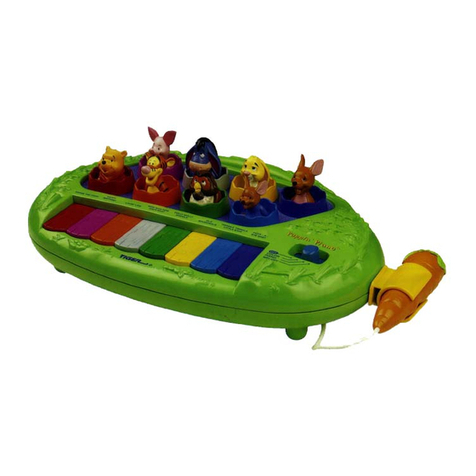
Tiger Electronics
Tiger Electronics Pooh Poppin' Piano 87-001 instruction manual

Baby Bear
Baby Bear Children mobile phone user manual
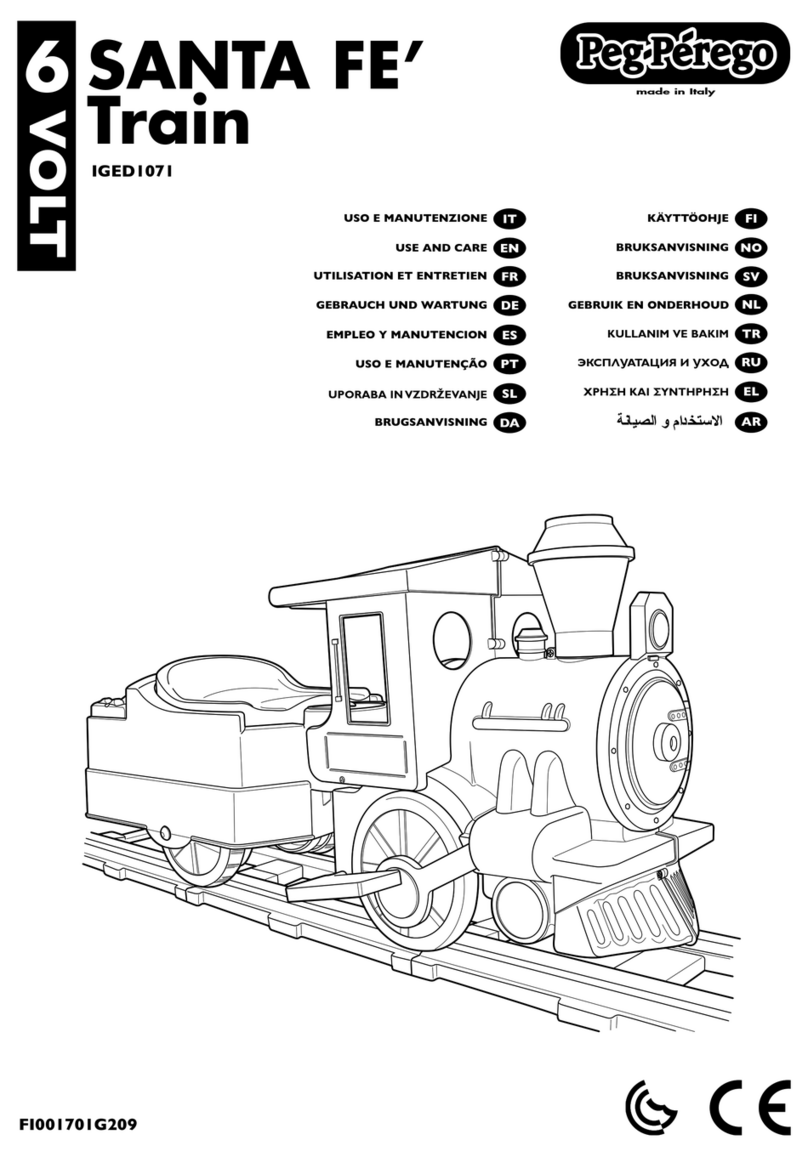
Peg-Perego
Peg-Perego SANTA FE' Train IGED1071 Use and care
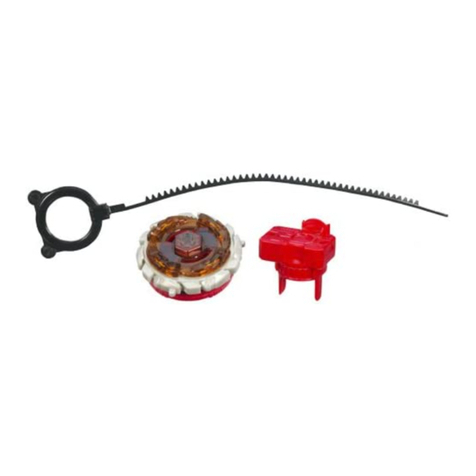
Beyblade
Beyblade B-12 instructions

Eduard
Eduard 49 737 Assembly instructions
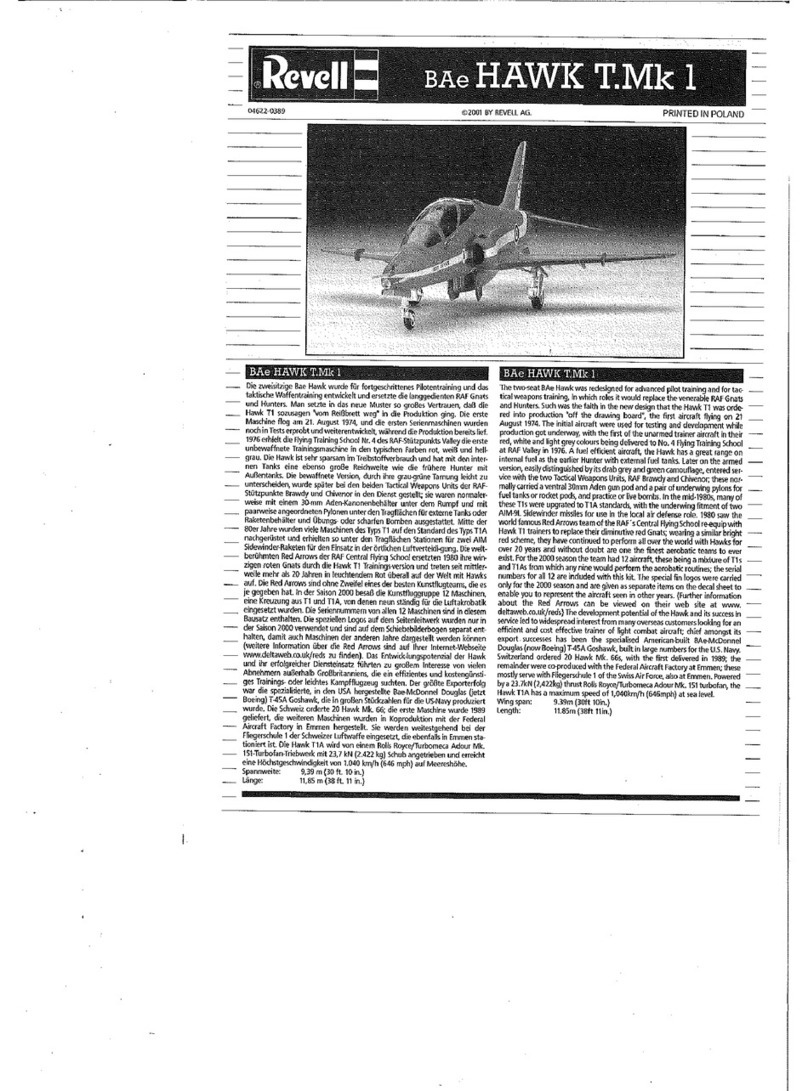
REVELL
REVELL BAe Hawk T.Mk1 Assembly manual
